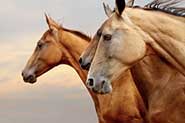The team, which included Dr Jakob Vinther of the University of Bristol, sequenced and analysed short pieces of DNA molecules preserved in bone-remnants from a horse frozen for the last 700,000 years in the permafrost of Yukon, Canada.
By tracking the genomic changes that transformed prehistoric wild horses into domestic breeds, the researchers have revealed the genetic make-up of modern horses with unprecedented detail. Their findings are published today in Nature.
DNA molecules can survive in fossils well after an organism dies, not as whole chromosomes but as short pieces that could be assembled back together, like a puzzle. Sometimes enough molecules survive so that the full genome sequence of an extinct species could be resurrected and over the past few years, the full genome sequence of a few ancient humans and archaic hominins has been characterized – but so far, none dated back more than 70,000 years. Now Dr Ludovic Orlando and Professor Eske Willerslev from Copenhagen's Centre for GeoGenetics and colleagues have beaten this DNA-record by about 10 times.
Sequencing the first genome from the Middle Pleistocene was by no means straightforward and involved collaboration between researchers from Denmark, China, Canada, the USA, Switzerland, the UK, Norway, France, Sweden and Saudi Arabia.
Dr Vinther's contribution to the study involved looking at the amino acid composition of the bone with a Time of Flight Secondary Ion Mass Spectroscope (TOF-SIMS). This analysis revealed the presence of abundant secondary ions characteristic of amino-acid peptides, particularly glycine, proline and alanine. These amino acids are characteristic of collagen which suggested that proteins had survived in situ.
Dr Orlando said: "We first got excited when we detected the signature of amino-acids that suggested proteins had survived. We got more excited when we proved able to directly sequence collagen peptides. When we detected blood proteins, it really started looking promising because those are barely preserved. At that stage, it could well be that ancient DNA could also be preserved."
And indeed DNA was present – in a tiny amount. Using Helicos true Single DNA Molecule Sequencing, the researchers managed to identify molecular preservation niches in the bone and experimental conditions that enabled finishing the full genome sequence.
Sequencing the genome allowed the scientists to track major genomic changes over the last 700,000 years of evolution of the horse lineage. By comparing the genome in the 700,000-year-old horse with the genome of a 43,000-year-old horse, six present day horses and the donkey, they found that the last common ancestor of all modern equids was living about 4.0-4.5 million years ago. Therefore, the evolutionary radiation underlying the origin of horses, donkeys and zebras reaches back in time twice as long as previously thought.
Professor Willerslev said: "The results of the studies and the applied techniques open up new doors for the exploration of prehistoric living creatures. Now with genomics and proteomics, we can reach ten times further back in time compared to before. And new knowledge about the horse’s evolutionary history has been added – a history which is considered as a classical example in evolutionary biology and a topic which is taught in high schools and universities."
Paper
'Recalibrating Equus evolution using the genome sequence of an early Middle Pleistocene horse' by Orlando et al in Nature
